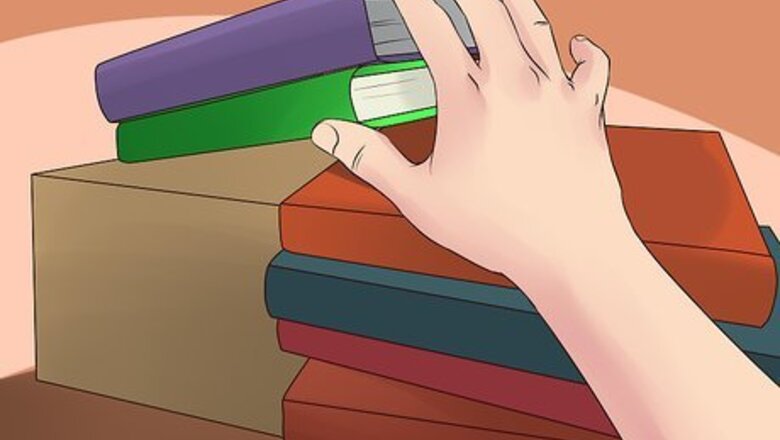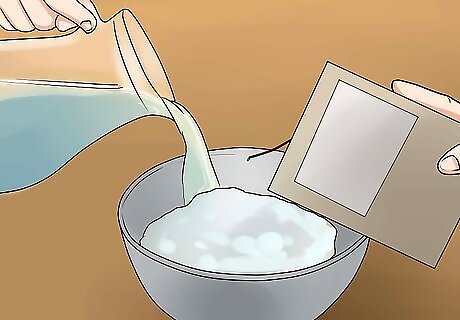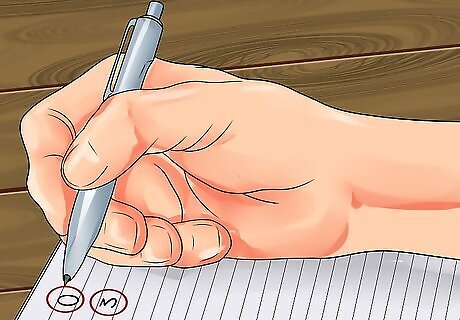
views
Being an Inventor for Kids

Get creative. If you want to be an inventor as a child, find ways to foster your creativity. Inventors know how to think outside the box and find new and innovative solutions to a variety of problems. You should look for ways to nurture your creative side. Give yourself time for spontaneous play. Put away the video games and sit alone in your room with a few basic toys, like stuffed animals and arts and craft supplies, each day. Read for pleasure. People who read a lot for pleasure tend to be vastly more creative than non-readers. Do artistic activities. Paint, color, sculpt with clay, write a poem, or do anything else that encourages creative thought.

Focus on STEM subjects in school. STEM stands for science, technology, engineering, and mathematics. These are all areas that are important if you want to be an inventor, as you'll need to have the expertise necessary to create your projects. In school, aim for a load heavy in STEM subjects. Take a lot of science courses in school. If your school offers advanced placement science courses, see if you can take these. You should also take courses on technology or engineering. See if your school offers classes on computer programming or courses like wood shop. Take a lot of high level math courses. A good knowledge of math is essential to becoming an inventor.

Join school clubs that will help you create. Learning from others is important to becoming an inventor, and there may be clubs in your school that encourage you to invent. Join a variety of after school clubs that will help you become an inventor. You could join a club like the Science Olympiads, where you'll learn a lot about science and technology. You could also try joining something like the chess club, which encourages logical thinking. In some schools, there are clubs where students work together on a single creation over the course of your semester. See if your school offers a club like this.

Practice hobbies that feed your imagination. Imagination is vital to becoming an inventor. Engage in a variety of hobbies that feed your imagination and allow you to develop the innovative mind of an inventor. Hobbies like baking sometimes require innovation. If you're out of cinnamon, for example, you'll have to improvise by finding a similar spice. Playing make-believe may seem like a waste of time, but it can actually nurture your imagination. If your characters get into difficult scenarios, you'll have to problem solve following the rules of your imaginary world. Take initiative in day-to-day moments to be creative. Look for pictures in the clouds. Make a poem about the afternoon rain.
Generating Ideas

Identify markets in need. To start, try to identify where there is a need for a new product. As an inventor, you should have an inquisitive mind. As you look at various products in your day-to-day life, identify gaps in the market. Look for places where there's room for improvement or innovation. Think about what market you're interested in. For example, if you're interested in music and electronics, think about what makes the iPod so desirable. Tap into what consumers want in a given market. Do people want to better themselves? Do they want entertainment, convenience? Each time you see someone enjoying a product or service, stop and ask yourself, "Why does this person use this service? What about this product is enjoyable to this person? What need is being met here?"

Think about what is missing. With any market, there's always something missing. The best inventors understand the fundamentals of a field and look for where it could be expanded. For example, the people who invented services like Uber and Lyft realized taxi services were no longer cutting it. People wanted a more personalized experience and craved the wide availability and convenience of calling a cab without having to make a phone call or find one on the street. Look into an existing market and ask yourself what is missing. Think about common complaints people have. Going back to the music example, what do your friends complain about regarding their iPods? What features do they want that are not currently provided by Apple? You can try asking friends to ascertain what's missing. For example, ask your friend, "If you could change one thing about your iPod, what would you change?" The answer could give you an idea for an invention for the music industry.

Expand on existing products. Some of the greatest inventions are simply expansions or innovations on existing products. Can you think of a new spin on an existing product or service? Can you find a way to make a longstanding, successful invention more convenient and desirable? If so, this may be a great product to try to invent and sell. Research the market before you begin. You want to ensure that your idea hasn't been done before. Someone may have tried your idea and found it unsuccessful for a various reasons. Ensure your idea is significantly different than existing ideas or products. If's too similar to something on the market, you could get in trouble for infringing on a copyright or patent.

Identify the skill set you need to get your idea off the ground. You may have a great idea, but do you have the skills necessary to produce it? Make a list of talents you need to create the product in question. If you do not have these talents yourself, you may have to dedicate some time to cultivating them before you get things rolling with your product. For example, you may have a stellar idea for a phone app, but little experience working with technology. You may have to take some coding classes for phone apps.

Do not be afraid to outsource. If you don't have all the skills you need, and do not want to take the time to develop them, do not be afraid to outsource. Inventors can rarely do everything they need to do in order to produce an invention. If you have certain weaknesses, that's okay. You can find others to help you in these areas. For example, if you don't know where to start on your phone app, find a freelance tech person online and see if they would be willing to do some of the work for you. You can also network with friends. If you have a friend who has a knack for building things, your friend may be willing to partner up with you to produce those hiking shoes. Whatever you do, make sure you sort out how to divide finances in the event your invention sells ahead of time.
Designing and Selling Your Products

Build a prototype. Once you've come up with an idea for an invention, you'll need to build a prototype. You can show this to prospective customers and buyers to generate interest in your product. You can also use a prototype as a model when you begin to build your physical product. Design software, like AutoDesk Inventor, can also help you build a digital prototype of your invention. While working digitally can help, try to make a small physical prototype. This will allow you to experience with materials and find the right combination to make your invention as solid as possible.

Cultivate interest for your idea. Once you have a solid prototype of your product, begin showing it off. There are a variety of ways you can generate interest in your idea. You want to look for potential investors and buyers. One way to build interest for your idea is to attend trade shows. You could even look into getting your own booth at a trade show and display your product. Another way to build interest is to network with other inventors and get a sense of what similar products are out there. You may have to tweak your product to give yourself an edge over the competition. Talk to a market research firm if it's within your budget. This can give you a sense of trends in the market you're working in, as well as general demographics.

Talk to a patent lawyer. If you believe you have a product that could potentially sell, contact a patent lawyer. You will want to get a patent on your product to make sure it doesn't get stolen by a competitor. It's vital to protect your intellectual property, especially if you think there's a market for it, so make sure you contact a patent lawyer. Search for a lawyer online, or in your local yellow pages, and make an appointment to discuss your product. Patent law is very complicated, so do not attempt to file a patent on your own unless you have extensive legal experience. If you have a friend who works in law, and who knows patent law, you may want to see if he or she will do some work for a discount price. Patents costs between $3,000 and $10,000 to file. While that may sound like a lot, if you've determined there's a market for your product it's well worth the cost. Patents take awhile to go through. It may take 3 years until you've successfully patented your product. Use this time to continue researching the market and tweaking your product to meet consumer needs.

Consider a fundraising campaign. It can be expensive to patent and market your product to the right audience. Consider doing an online marketing campaign through a site like Kickstarter or GoFundMe. In addition to giving the money necessary to get your product off the ground, this can also help generate public interest. Consider the best way to reach your target audience. Social media would work well for a younger audience, while an older audience may respond better to mass emails. Keep your audience up-to-date on your goals and let them know how close you are to reaching them. Tell your audience about your product and be honest about how the money will be used. People will be more likely to donate if they know where their money is going. Allow people to share information easily. A sidebar on your fundraising page will allow people to post details of your page to social media outlets like Facebook and Twitter.

Decide whether to sell your idea or make it yourself. After generating public interest and patenting your product, decide what you want to do with your idea. Investors usually either sell licenses of their products to larger companies, or create and sell products themselves. Figure out which path is right for you. If you want to sell the product yourself, consider whether you have the time and resources to do so. You may have to quit your job or reduce your hours. You should also weigh the costs of the resources it will take to build the product. The upside to selling your license is that you make money from royalties. You may not have to quit your current job, but you may give up a lot of money this route. On average, patent holders make about 2-7% of retail sales on their products.
Coping with Setbacks

Learn when to give up on bad ideas. Good inventors do not get too attached to their ideas. Not every idea you have will be a winner. Some ideas simply do not work. Be ready to give up on an idea if it's not practical. Be willing to detach yourself from your ideas. Do not personalize rejection. Some ideas simply do not work as well as others. Becoming an inventor is about numbers. The more ideas you have, the more likely you are to find one that works.

Keep your day job. Even if you think you have a solid idea, keep your day job. You want to make sure you have a steady source of income until you start regularly making money from an invention. In the world of inventing, a lot is left up to chance. Even if you think you have an investor in your idea, a lot of could still go wrong. It may take years before you have a successful invention, so keep your day job until then.

Take rejection with stride. Rejection will happen along the way to success. If you want to be an inventor, you need to learn to take rejection in stride. If you do not do so, you'll have trouble succeeding in the field. Rejection happens to everyone. Try to remember most successful people faced rejection at some point in their professional lives. Rejection is rarely personal. There are thousands of products on the market. Just because yours did not sell or appeal to anyone does not mean it was not a good idea.



















Comments
0 comment